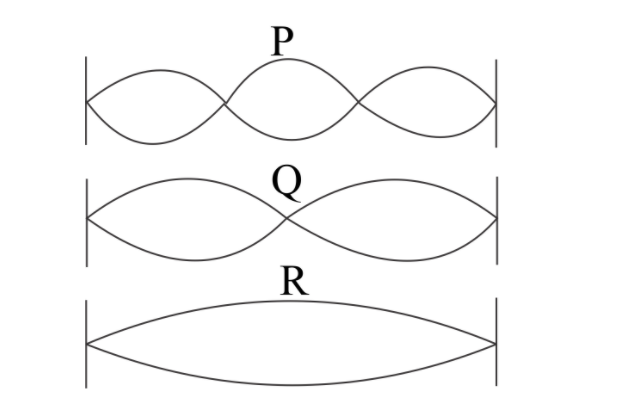
The diagram below Shows three different modes of vibrations $P$, $Q$ and $R$ of the same string. The sound of which string will have maximum shrillness.

Answer
216.6k+ views
Hint We know that the shrillness of a wave or vibration is directly proportional to frequency of wave. Loudness of vibration depends on its amplitude. Then the vibration with maximum frequency has maximum shrillness.
Complete step by step solution
We know that the shrillness of a wave or vibration is directly proportional to frequency of wave. Then the vibration with maximum frequency has maximum shrillness.
In the above diagram, vibration $P$ covers three loops, vibration $Q$ covers two loops when vibration $R$ covers only one loop.
Means vibration in string $P$ has more frequency than other two string $Q$ and $R$. Then frequency of vibration $P$ is maximum among all three vibrations.
We know maximum frequency means maximum shrillness. Then vibration $P$ has maximum shrillness.
Hence the answer is $P$.
Note: We know that sound is also the vibration of a particle. And loudness of sound depends on amplitude of sound wave and shrillness of sound depends on frequency of sound. To increase loudness of sound we just need to increase the amplitude of sound. And we never change the frequency of sound because all information is just a varying frequency of sound wave. If we do so the message in sound changes.
Complete step by step solution
We know that the shrillness of a wave or vibration is directly proportional to frequency of wave. Then the vibration with maximum frequency has maximum shrillness.
In the above diagram, vibration $P$ covers three loops, vibration $Q$ covers two loops when vibration $R$ covers only one loop.
Means vibration in string $P$ has more frequency than other two string $Q$ and $R$. Then frequency of vibration $P$ is maximum among all three vibrations.
We know maximum frequency means maximum shrillness. Then vibration $P$ has maximum shrillness.
Hence the answer is $P$.
Note: We know that sound is also the vibration of a particle. And loudness of sound depends on amplitude of sound wave and shrillness of sound depends on frequency of sound. To increase loudness of sound we just need to increase the amplitude of sound. And we never change the frequency of sound because all information is just a varying frequency of sound wave. If we do so the message in sound changes.
Recently Updated Pages
JEE Atomic Structure and Chemical Bonding important Concepts and Tips

JEE Amino Acids and Peptides Important Concepts and Tips for Exam Preparation

Electricity and Magnetism Explained: Key Concepts & Applications

Chemical Properties of Hydrogen - Important Concepts for JEE Exam Preparation

JEE Energetics Important Concepts and Tips for Exam Preparation

JEE Isolation, Preparation and Properties of Non-metals Important Concepts and Tips for Exam Preparation

Trending doubts
JEE Main 2026: Application Form Open, Exam Dates, Syllabus, Eligibility & Question Papers

Derivation of Equation of Trajectory Explained for Students

Hybridisation in Chemistry – Concept, Types & Applications

Understanding the Angle of Deviation in a Prism

Understanding Collisions: Types and Examples for Students

How to Convert a Galvanometer into an Ammeter or Voltmeter

Other Pages
JEE Advanced Marks vs Ranks 2025: Understanding Category-wise Qualifying Marks and Previous Year Cut-offs

Units And Measurements Class 11 Physics Chapter 1 CBSE Notes - 2025-26

NCERT Solutions For Class 11 Physics Chapter 8 Mechanical Properties Of Solids

Motion in a Straight Line Class 11 Physics Chapter 2 CBSE Notes - 2025-26

NCERT Solutions for Class 11 Physics Chapter 7 Gravitation 2025-26

Understanding Atomic Structure for Beginners




